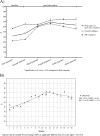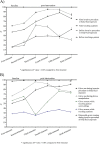Effectiveness over time of a multimodal intervention to improve compliance with standard hygiene precautions in an intensive care unit of a large teaching hospital
- PMID: 31164981
- PMCID: PMC6544958
- DOI: 10.1186/s13756-019-0544-0
Effectiveness over time of a multimodal intervention to improve compliance with standard hygiene precautions in an intensive care unit of a large teaching hospital
Abstract
Background: Standard hygiene precautions are an effective way of controlling healthcare-associated infections. Nevertheless, compliance with hand hygiene (HH) guidelines among healthcare workers (HCWs) is often poor, and evidence regarding appropriate use of gloves and gowns is limited and not encouraging. In this study, we evaluated the ability over time of a multimodal intervention to improve HCWs compliance with standard hygiene precautions.
Methods: Trend analysis of direct observations of compliance with HH guidelines and proper glove or gown use was conducted in the medical/surgical intensive care unit (ICU) of Umberto I Teaching Hospital of Sapienza University of Rome. The study consisted of two phases: a six-month baseline phase and a 12-month post-intervention phase. The multimodal intervention was based on the World Health Organization strategy and included education and training of HCWs, together with performance feedback.
Results: A total of 12,853 observations were collected from November 2016 to April 2018. Overall compliance significantly improved from 41.9% at baseline to 62.1% (p < 0.001) after the intervention and this improvement was sustained over the following trimesters. Despite variability across job categories and over the study period, a similar trend was observed for most investigations. The main determinants of compliance were job category (with nurses having the highest compliance rates), being a member of ICU staff and whether delivering routine, as opposed to emergency, care. HH compliance was modified by glove use; unnecessary gloving negatively affected HH behaviour while appropriate gloving positively influenced it.
Conclusions: The multimodal intervention resulted in a significant improvement in compliance with standard hygiene precautions. However, regular educational reinforcement and feedback is essential to maintain a high and uniform level of compliance.
Keywords: Compliance; Infection control; Standard hygiene precautions; WHO multimodal strategy.
Conflict of interest statement
Competing interestsThe authors declare that they have no competing interests.
Figures


Similar articles
-
Impact of implementation of a modified World Health Organization multimodal hand hygiene strategy in a university teaching hospital.Am J Infect Control. 2020 Mar;48(3):249-254. doi: 10.1016/j.ajic.2019.07.019. Epub 2019 Oct 7. Am J Infect Control. 2020. PMID: 31601445
-
Effectiveness of hand hygiene promotional program based on the WHO multimodal hand hygiene improvement strategy, in terms of compliance and decontamination efficacy in an indian tertiary level neonatal surgical intensive care unit.Indian J Med Microbiol. 2019 Oct-Dec;37(4):496-501. doi: 10.4103/ijmm.IJMM_20_47. Indian J Med Microbiol. 2019. PMID: 32436870
-
Mixed methods study evaluating the implementation of the WHO hand hygiene strategy focusing on alcohol based handrub and training among health care workers in Faranah, Guinea.PLoS One. 2021 Aug 26;16(8):e0256760. doi: 10.1371/journal.pone.0256760. eCollection 2021. PLoS One. 2021. PMID: 34437634 Free PMC article.
-
Hand Hygiene Compliance in the ICU: A Systematic Review.Crit Care Med. 2019 Sep;47(9):1251-1257. doi: 10.1097/CCM.0000000000003868. Crit Care Med. 2019. PMID: 31219838
-
Irritant Contact Dermatitis on Hands.Am J Med Qual. 2017 Jan/Feb;32(1):93-99. doi: 10.1177/1062860615611228. Epub 2016 Jul 9. Am J Med Qual. 2017. PMID: 26472960 Review.
Cited by
-
INteractive Virtual Expert-Led Skills Training: A Multi-Modal Curriculum for Medical Trainees.Front Psychiatry. 2021 Jun 23;12:671442. doi: 10.3389/fpsyt.2021.671442. eCollection 2021. Front Psychiatry. 2021. PMID: 34248708 Free PMC article.
-
Impact of target site mutations and plasmid associated resistance genes acquisition on resistance of Acinetobacter baumannii to fluoroquinolones.Sci Rep. 2021 Oct 11;11(1):20136. doi: 10.1038/s41598-021-99230-y. Sci Rep. 2021. PMID: 34635692 Free PMC article.
-
Comparing the Occurrence of Healthcare-Associated Infections in Patients with and without COVID-19 Hospitalized during the Pandemic: A 16-Month Retrospective Cohort Study in a Hospital Intensive Care Unit.J Clin Med. 2022 Mar 7;11(5):1446. doi: 10.3390/jcm11051446. J Clin Med. 2022. PMID: 35268538 Free PMC article.
-
Central Line Associated Bloodstream Infections in Critical Ill Patients during and before the COVID-19 Pandemic.Healthcare (Basel). 2023 Aug 29;11(17):2415. doi: 10.3390/healthcare11172415. Healthcare (Basel). 2023. PMID: 37685449 Free PMC article.
-
Impact of multimodal strategies to reduce multidrug-resistant organisms in surgical intensive care units: Knowledge, practices and transmission: A quasi-experimental study.Nurs Open. 2021 Jul;8(4):1937-1946. doi: 10.1002/nop2.864. Epub 2021 Mar 24. Nurs Open. 2021. PMID: 33760380 Free PMC article.
References
-
- Trick WE, Vernon MO, Welbel SF, DeMarais P, Hayden MK, Weinstein RA. Multicenter intervention program to increase adherence to hand hygiene recommendations and glove use and to reduce the incidence of antimicrobial resistance. Infect Control Hosp Epidemiol. 2007;28(01):42–49. doi: 10.1086/510809. - DOI - PubMed
-
- World Health Organisation (WHO) Evidence of hand hygiene to reduce transmission and infections by multi-drug resistant organisms in health-care settings. Geneva: WHO; 2009.
-
- World Health Organization (WHO) WHO guidelines on hand hygiene in health care: first global patient safety challenge clean care is safer care. Geneva: WHO; 2009. - PubMed
-
- World Health Organization & WHO Patient Safety. A guide to the implementation of the WHO multimodal hand hygiene improvement strategy. Geneva: WHO; 2009. p. 2009. https://www.who.int/gpsc/5may/Guide_to_Implementation.pdf.
-
- Chen Yee-Chun, Sheng Wang-Huei, Wang Jann-Tay, Chang Shan-Chwen, Lin Hui-Chi, Tien Kuei-Lien, Hsu Le-Yin, Tsai Keh-Sung. Effectiveness and Limitations of Hand Hygiene Promotion on Decreasing Healthcare–Associated Infections. PLoS ONE. 2011;6(11):e27163. doi: 10.1371/journal.pone.0027163. - DOI - PMC - PubMed
Publication types
MeSH terms
LinkOut - more resources
Full Text Sources
Medical
Miscellaneous

